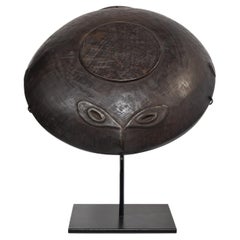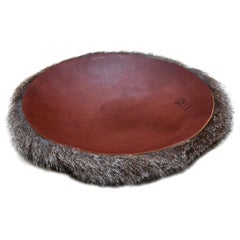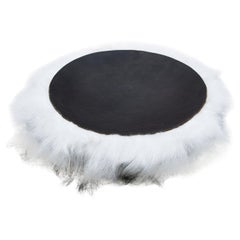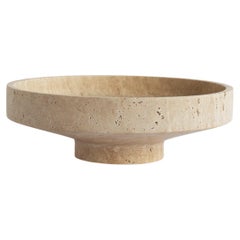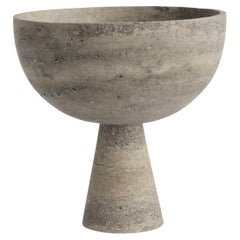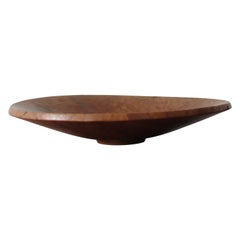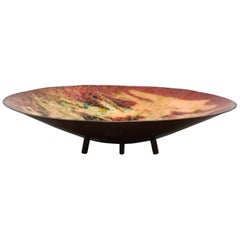Oceanic Serving Bowls
8
1
to
5
9
9
9
1
8
1
8
8
8
8
6
3,289
1,452
368
360
330
8
Place of Origin: Oceanic
20th Century Oceanic Wood Feast Platter with Stylized Flying Fox Motif
Located in Point Richmond, CA
20th Century Oceanic Wood Feast Platter with Stylized Flying Fox Motif
Boiken Peoples, East Sepik Province, Papua New Guinea
The platter's rich dark brown ...
Category
Mid-20th Century Other Oceanic Serving Bowls
Materials
Wood
Hairy Wild Man from Botany Bay Bowl Black by Trent Jansen
By Trent Jansen
Located in Beverly Hills, CA
Broached Monsters by Trent Jansen
The vast majority of mainstream Australian mythology commonly used as a
foundation for Australian identity is culturally exclusive. Both Indigenou...
Category
21st Century and Contemporary Oceanic Serving Bowls
Materials
Aluminum
Pankalangu Bowl
By Trent Jansen
Located in Beverly Hills, CA
Broached monsters by Trent Jansen
The vast majority of mainstream Australian mythology commonly used as a
foundation for Australian identity is culturally exclusive. Both Indigenou...
Category
21st Century and Contemporary Oceanic Serving Bowls
Materials
Aluminum
Pankalangu Bowl
By Trent Jansen
Located in Beverly Hills, CA
Broached monsters by Trent Jansen
The vast majority of mainstream Australian mythology commonly used as a
foundation for Australian identity is culturally exclusive. Both Indigenous myths, including post-colonial myths and precolonial dreaming stories, and non-indigenous Australian myths, including the bush legend, ANZAC tradition and convict legend, focus on the historical role that the race of authorship has played in building the nation. However, a contemporary understanding of Australian history acknowledges the contribution of both Indigenous and non-indigenous Australians in forging the nation, and the national identity which accompanies it. Instead of perpetuating the same exclusive national myths, perhaps Australians should adopt a national mythology that acknowledges this inclusive understanding of Australian history, a mythology that unites Australians of many backgrounds under a shared Australian identity.
In his book on Australia’s Folklore of Fear, Robert Holden explores pre-colonial ideas of Australia as a Great Southern Land – an imaginary landmass conjured up to counterbalance the continents in the northern hemisphere, as far removed as possible from Britain, the center of the Christian world (Holden, 2001). Holden speaks of Australia as an imaginary world, occupied by unimaginable creatures and monsters.
Holden is commenting in part on the mythical creatures that originated in both British and Aboriginal Australian folklore and were shared by the Aboriginal and non-Aboriginal inhabitants of Sydney during the early years of colonisation. Stories of the yahoo, a creature that resembled a slender man, with long white straight hair, extraordinarily long arms and great talons (Unknown 1842), captured the imaginations of the new British settlers, and soon a fear of the yahoo became a common ground between Aboriginal people and British settlers. is fear of a gruesome and vicious creature gained its potency from the folkloric tales that were used to substantiate its existence. These tales were suitably vague, their lack of detail
attributed to the fierce nature of these creatures and the assumption that no one had survived an encounter (Holden, Thomas et al. 2001).
The yahoo “became one of the very few Aboriginal legends to be embraced by the Europeans” (Holden, Thomas et al. 2001, p16), providing a catalyst for conversation between individuals from these two culturally disparate societies and forming some personal links between these communities. Could creature myths like the yahoo once again form the foundation of a united national...
Category
21st Century and Contemporary Oceanic Serving Bowls
Materials
Aluminum
Hairy Wild Man from Botany Bay Bowl Grey by Trent Jansen
By Trent Jansen
Located in Beverly Hills, CA
Broached monsters by Trent Jansen
The vast majority of mainstream Australian mythology commonly used as a
foundation for Australian identity is culturally exclusive. Both Indigenous myths, including post-colonial myths and precolonial dreaming stories, and non-indigenous Australian myths, including the bush legend, ANZAC tradition and convict legend, focus on the historical role that the race of authorship has played in building the nation. However, a contemporary understanding of Australian history...
Category
21st Century and Contemporary Oceanic Serving Bowls
Materials
Aluminum
Hairy Wild Man from Botany Bay Bowl White by Trent Jansen
By Trent Jansen
Located in Beverly Hills, CA
Broached Monsters by Trent Jansen
The vast majority of mainstream Australian mythology commonly used as a
foundation for Australian identity is culturally exclusive. Both Indigenous myths, including post-colonial myths and precolonial dreaming stories, and non-indigenous Australian myths, including the bush legend, ANZAC tradition and convict legend, focus on the historical role that the race of authorship has played in building the nation. However, a contemporary understanding of Australian history...
Category
21st Century and Contemporary Oceanic Serving Bowls
Materials
Aluminum
Hairy Wild Man from Botany Bay Bowl Grey by Trent Jansen
By Trent Jansen
Located in Beverly Hills, CA
Broached monsters by Trent Jansen
The vast majority of mainstream Australian mythology commonly used as a
foundation for Australian identity is culturally exclusive. Both Indigenous myths, including post-colonial myths and precolonial dreaming stories, and non-indigenous Australian myths, including the bush legend, ANZAC tradition and convict legend, focus on the historical role that the race of authorship has played in building the nation. However, a contemporary understanding of Australian history acknowledges the contribution of both Indigenous and non-indigenous Australians in forging the nation, and the national identity which accompanies it. Instead of perpetuating the same exclusive national myths, perhaps Australians should adopt a national mythology that acknowledges this inclusive understanding of Australian history, a mythology that unites Australians of many backgrounds under a shared Australian identity.
In his book on Australia’s Folklore of Fear, Robert Holden explores pre-colonial ideas of Australia as a Great Southern Land – an imaginary landmass conjured up to counterbalance the continents in the northern hemisphere, as far removed as possible from Britain, the center of the Christian world (Holden, 2001). Holden speaks of Australia as an imaginary world, occupied by unimaginable creatures and monsters.
Holden is commenting in part on the mythical creatures that originated in both British and Aboriginal Australian folklore and were shared by the Aboriginal and non-Aboriginal inhabitants of Sydney during the early years of colonisation. Stories of the yahoo, a creature that resembled a slender man, with long white straight hair, extraordinarily long arms and great talons (Unknown 1842), captured the imaginations of the new British settlers, and soon a fear of the yahoo became a common ground between Aboriginal people and British settlers. is fear of a gruesome and vicious creature gained its potency from the folkloric tales that were used to substantiate its existence. These tales were suitably vague, their lack of detail
attributed to the fierce nature of these creatures and the assumption that no one had survived an encounter (Holden, Thomas et al. 2001).
The yahoo “became one of the very few Aboriginal legends to be embraced by the Europeans” (Holden, Thomas et al. 2001, p16), providing a catalyst for conversation between individuals from these two culturally disparate societies and forming some personal links between these communities. Could creature myths like the yahoo once again form the foundation of a united national...
Category
21st Century and Contemporary Oceanic Serving Bowls
Materials
Aluminum
Hairy Wild Man from Botany Bay Bowl White by Trent Jansen
By Trent Jansen
Located in Beverly Hills, CA
Broached Monsters by Trent Jansen
The vast majority of mainstream Australian mythology commonly used as a
foundation for Australian identity is culturally exclusive. Both Indigenou...
Category
21st Century and Contemporary Oceanic Serving Bowls
Materials
Aluminum
Hairy Wild Man from Botany Bay Bowl Black by Trent Jansen
By Trent Jansen
Located in Beverly Hills, CA
Broached Monsters by Trent Jansen
The vast majority of mainstream Australian mythology commonly used as a
foundation for Australian identity is culturally exclusive. Both Indigenous myths, including post-colonial myths and precolonial dreaming stories, and non-indigenous Australian myths, including the bush legend, ANZAC tradition and convict legend, focus on the historical role that the race of authorship has played in building the nation. However, a contemporary understanding of Australian history acknowledges the contribution of both Indigenous and non-indigenous Australians in forging the nation, and the national identity which accompanies it. Instead of perpetuating the same exclusive national myths, perhaps Australians should adopt a national mythology that acknowledges this inclusive understanding of Australian history, a mythology that unites Australians of many backgrounds under a shared Australian identity.
In his book on Australia’s Folklore of Fear, Robert Holden explores pre-colonial ideas of Australia as a Great Southern Land – an imaginary landmass conjured up to counterbalance the continents in the northern hemisphere, as far removed as possible from Britain, the center of the Christian world (Holden, 2001). Holden speaks of Australia as an imaginary world, occupied by unimaginable creatures and monsters.
Holden is commenting in part on the mythical creatures that originated in both British and Aboriginal Australian folklore and were shared by the Aboriginal and non-Aboriginal inhabitants of Sydney during the early years of colonization. Stories of the yahoo, a creature that resembled a slender man, with long white straight hair, extraordinarily long arms and great talons (Unknown 1842), captured the imaginations of the new British settlers, and soon a fear of the yahoo became a common ground between Aboriginal people and British settlers. is fear of a gruesome and vicious creature gained its potency from the folkloric tales that were used to substantiate its existence. These tales were suitably vague, their lack of detail
attributed to the fierce nature of these creatures and the assumption that no one had survived an encounter (Holden, Thomas et al. 2001).
The yahoo “became one of the very few Aboriginal legends to be embraced by the Europeans” (Holden, Thomas et al. 2001, p16), providing a catalyst for conversation between individuals from these two culturally disparate societies and forming some personal links between these communities. Could creature myths like the yahoo once again form the foundation of a united national...
Category
21st Century and Contemporary Oceanic Serving Bowls
Materials
Aluminum
Related Items
Travertine Narrow Bowl
By Kiwano Concept
Located in EINDHOVEN, NB
Stunning, aesthetic, timeless are words that can be used to describe this elegant and modern travertine bowl from Kiwano. Expertly crafted and finished by hand, our travertine bowls ...
Category
2010s Modern Oceanic Serving Bowls
Materials
Travertine
Silver Travertine Bowl XL
By Kiwano Concept
Located in EINDHOVEN, NB
A substantial silver travertine bowl with unique structure rests atop a pedestal for a grand presentation of fruits and vegetables.
Due to the nature of the material, each piece ...
Category
2010s Modern Oceanic Serving Bowls
Materials
Travertine
Travertine Eclipse Bowl
By Kiwano Concept
Located in EINDHOVEN, NB
Stunning, aesthetic, timeless are words that can be used to describe this elegant and modern travertine Eclipse bowl from Kiwano. Expertly crafted and finished by hand, our travertin...
Category
2010s Modern Oceanic Serving Bowls
Materials
Travertine
Silver Travertine Narrow Bowl
By Kiwano Concept
Located in EINDHOVEN, NB
Stunning, aesthetic, timeless are words that can be used to describe this elegant and modern travertine bowl from Kiwano. Expertly crafted and finished by hand, our travertine bowls ...
Category
2010s Modern Oceanic Serving Bowls
Materials
Travertine
Pink Marble Narrow Bowl
By Kiwano Concept
Located in EINDHOVEN, NB
Stunning, aesthetic, timeless are words that can be used to describe this elegant and modern pink marble narrow bowl from Kiwano. Expertly crafted and finished by hand, our traverti...
Category
2010s Modern Oceanic Serving Bowls
Materials
Travertine
Vintage Silver Sugar Bowl, 20th Century
Located in Roma, IT
Silver sugar bowl is a precious decorative object realized in 20th century.
Very precious sugar bowl with very refined decorations. Weight: Kgs 0...
Category
20th Century Oceanic Serving Bowls
Materials
Sterling Silver
Travertine Bowl With Lid
Located in EINDHOVEN, NB
Stunning, aesthetic, timeless are words that can be used to describe this elegant and modern travertine bowl from Kiwano. Expertly crafted and finished by hand, our travertine vases ...
Category
2010s Modern Oceanic Serving Bowls
Materials
Marble
19th Century Venetian Creamware Covered Soup Bowl with Floral Motifs
Located in Leesburg, VA
A 19th century vintage creamware soup bowl with lid decorated with elaborate and beautiful floral motifs.
Approximate Size: 7.75” x 6.25” (h)
C...
Category
Mid-19th Century Renaissance Revival Antique Oceanic Serving Bowls
Materials
Creamware
Large Danish Teak Bowl by Richard Nissen
By Richard Nissen, Nissen
Located in Fort Lauderdale, FL
Large vintage danish teak bowl by Nissen.
Designer: Richard Nissen
Manufacturer: Nissen Studios
Year: 1960s
Origin: Denmark
Dimensions: 5" tall x 11" diameter.
Category
Mid-20th Century Mid-Century Modern Oceanic Serving Bowls
Materials
Teak
Brazilian Jacaranda Rosewood Bowl by Jac-Arte
By Jean Gillon
Located in Fort Lauderdale, FL
Vintage Brazilian modern bowl crafted in solid Jacaranda Rosewood by Jac-Arte.
Maker: Jac Art
Year: 1960s
Origin: Brazil
Style: Mid Century Modern
Dimensions: 9.5" wid...
Category
Mid-20th Century Mid-Century Modern Oceanic Serving Bowls
Materials
Jacaranda, Rosewood
Vintage Mexican Terracotta Bowl
Located in Chicago, IL
A beautiful vintage Mexican terracotta bowl with two handles, a ruffled lip, two large drip glazed splotches inside. The exterior is unglazed. Perfect f...
Category
20th Century Rustic Oceanic Serving Bowls
Materials
Terracotta
Massive Glazed Terracotta Bowl
Located in Chicago, IL
A massive vintage Mexican glazed terracotta bowl with two applied handles and a beautiful drip glazed pattern on the interior. The exterior is u...
Category
20th Century Rustic Oceanic Serving Bowls
Materials
Terracotta
Previously Available Items
Vintage Hand Produced Australian Burr Wood Bowl
Located in Stow on the Wold, GB
Wonderful textured wooden bowl dating from the 1990s. Hand produced from Australian Box Burr. Stamped to the underside Lex Whadcoat 93 white box burr.
In good vintage condition, th...
Category
20th Century Oceanic Serving Bowls
Materials
Wood
Modernist Australian Studio Copper Enamel Footed Bowl 1960s or 1970s
Located in Melbourne, AU
This is a superb footed bowl most likely by an Australian artist, dating from the late 1960s-early 1970s.
It has some exceptional qualities that indicate it was produced by a professional artist or highly skilled craftsperson. Firstly, the base vessel has been carefully constructed with three delicate feet to elevate and enhance the lovely shape of the bowl. Then there’s the restrained but expressive design, including the confident application of abstract pattern to the copper surface by means of acid etching. Finally, the translucent vitreous enamel with minimal but beautiful color application shows a judicious and considered understanding of technique, material and color effect.
The result is a wonderful piece of late 1960s or early 1970s modernist art/craft which strongly reminds us of the work of Leonard...
Category
1970s Brutalist Vintage Oceanic Serving Bowls
Materials
Copper
Old sculptural Oceanic wood bowl
Located in Los Angeles, CA
Very old Ramu River wood food bowl with zoomorphic heads at each end, great black aged patina.
Category
Early 20th Century Oceanic Serving Bowls
Materials
Wood
Recently Viewed
View AllMore Ways To Browse
French Silver Confiturier
Cut Crystal Antique Punch
Italian Art Glass Punch Bowl Set
Silver Confiturier
Bennington Ware
Kaj Bojesen Teak Bowl
Vintage Catherineholm
D W Haber
Guzzini Napkin
Spode Punch Bowl
Digsmed Nutcracker And Bowl
Coors Ceramics
Kaj Bojesen Finn Juhl
Jacobi And Jenkins Sterling
Pink Marble Pedestal Bowl
Pressed Glass Punch Bowl
Batter Bowl Vintage
19th Century Ceramic Punch Bowls
